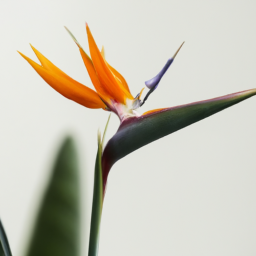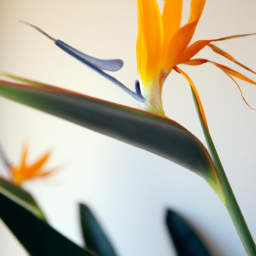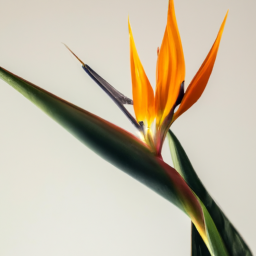
Are you looking to bring a touch of tropical paradise into your home with indoor plants similar to Bird of Paradise? Look no further! With their large, banana-like leaves and vibrant flowers, Bird of Paradise plants are a popular choice for adding a touch of exotic flair to any indoor space. In this blog post, we will explore some other indoor plants that share similar characteristics to the iconic Bird of Paradise, allowing you to create a lush and tropical oasis right in your own home. Let’s dive in and discover some fantastic alternatives to the Bird of Paradise plant!
Types of Indoor Plants that Resemble Bird of Paradise
1. Peace Lily
When it comes to indoor plants that resemble the Bird of Paradise, the Peace Lily is a popular choice. With its large, glossy green leaves and striking white flowers, the Peace Lily adds a touch of tropical elegance to any indoor space. This plant thrives in low light conditions, making it perfect for those areas of your home that don’t get a lot of natural sunlight.
One of the key similarities between the Peace Lily and the Bird of Paradise is their ability to purify the air. The Peace Lily is known for its air-purifying properties, helping to remove toxins such as formaldehyde and benzene from the air in your home. This makes it not only a beautiful addition to your indoor space but also a healthy one.
To care for your Peace Lily, be sure to keep the soil consistently moist but not waterlogged. It’s also important to mist the leaves regularly to maintain the plant’s humidity levels. With proper care, your Peace Lily will thrive and continue to bring beauty and health benefits to your indoor space.
2. White Bird of Paradise
Another indoor plant that closely resembles the Bird of Paradise is the White Bird of Paradise. With its large, banana-like leaves and striking white flowers, this plant adds a touch of tropical flair to any indoor space. The White Bird of Paradise thrives in bright, indirect light and can grow quite large, making it a statement piece in any room.
Like the Bird of Paradise, the White Bird of Paradise requires regular watering and well-draining soil to prevent root rot. It’s also important to mist the leaves regularly to maintain the plant’s humidity levels. With proper care, the White Bird of Paradise will continue to grow and flourish, adding a touch of tropical beauty to your indoor space.
One of the key differences between the White Bird of Paradise and the Bird of Paradise is the size of their flowers. While the Bird of Paradise has large, colorful flowers, the White Bird of Paradise has smaller, white flowers that add a delicate touch to the plant’s overall appearance. Both plants, however, are equally stunning and make a beautiful addition to any indoor space.
3. Banana Plant
If you’re looking for an indoor plant that resembles the Bird of Paradise but has a unique twist, the Banana Plant is a great choice. With its large, broad leaves and tropical vibe, the Banana Plant adds a touch of exotic beauty to any indoor space. This plant thrives in bright, indirect light and requires regular watering to keep its soil moist.
One of the key similarities between the Banana Plant and the Bird of Paradise is their large, broad leaves that add a tropical feel to any room. The Banana Plant’s leaves can grow quite large, making it a statement piece in any indoor space. Like the Bird of Paradise, the Banana Plant requires regular misting to maintain its humidity levels and prevent the leaves from drying out.
To care for your Banana Plant, be sure to keep it in a warm, humid environment and water it regularly to keep the soil moist. With proper care, your Banana Plant will continue to grow and thrive, adding a touch of tropical beauty to your indoor space.

Best Indoor Plants with Similar Growth Requirements to Bird of Paradise
1. Peace Lily
Peace lilies are a popular choice for indoor plants due to their elegant white flowers and easy care requirements. Like the bird of paradise plant, peace lilies thrive in bright, indirect light but can also tolerate lower light conditions. They prefer well-draining soil and should be watered when the top inch of soil feels dry to the touch. Peace lilies are also known for their air-purifying qualities, making them a great addition to any indoor space.
In terms of size, peace lilies can grow up to 3 feet tall and wide, making them a statement plant in any room. They do not require frequent repotting and can be left in the same container for several years. Peace lilies are also relatively pest-resistant, although they may attract spider mites if kept in a dry environment. Regular misting can help prevent this issue.
Overall, peace lilies are a great choice for indoor plant enthusiasts looking for a plant with similar growth requirements to the bird of paradise. With proper care and attention, peace lilies can thrive and add beauty to any indoor space.
2. Rubber Plant
Rubber plants are another indoor plant option that shares similar growth requirements with the bird of paradise. These plants have large, glossy leaves that add a touch of tropical flair to any room. Like the bird of paradise, rubber plants prefer bright, indirect light but can also tolerate lower light conditions. They should be watered when the top inch of soil feels dry to the touch and benefit from occasional misting to increase humidity.
Rubber plants can grow quite large, reaching heights of up to 8 feet indoors. They are relatively low-maintenance and only need to be repotted every few years. Rubber plants are also known for their air-purifying qualities, making them a great choice for indoor spaces. However, they are toxic to pets if ingested, so care should be taken when placing them in homes with animals.
In conclusion, rubber plants are a fantastic option for indoor plant enthusiasts looking for a plant with similar growth requirements to the bird of paradise. With proper care and attention, rubber plants can thrive and bring a touch of the tropics to any indoor space.
3. Monstera Deliciosa
Monstera deliciosa, also known as the Swiss cheese plant, is a popular choice for indoor plant enthusiasts due to its unique foliage and easy care requirements. Like the bird of paradise, monstera deliciosa prefers bright, indirect light but can also tolerate lower light conditions. They should be watered when the top inch of soil feels dry to the touch and benefit from occasional misting to increase humidity.
Monstera deliciosa can grow quite large, with mature plants reaching heights of up to 10 feet indoors. They are relatively low-maintenance and only need to be repotted every few years. Monstera deliciosa is also known for its air-purifying qualities, making it a great choice for indoor spaces. However, they are toxic to pets if ingested, so care should be taken when placing them in homes with animals.
In summary, monstera deliciosa is an excellent option for indoor plant enthusiasts looking for a plant with similar growth requirements to the bird of paradise. With proper care and attention, monstera deliciosa can thrive and add a touch of tropical elegance to any indoor space.

How to Care for Indoor Plants that Mimic the Bird of Paradise
Choosing the Right Indoor Plants
When it comes to selecting indoor plants that resemble the Bird of Paradise, there are a few key options to consider. One popular choice is the White Bird of Paradise, also known as the Giant Bird of Paradise. This plant features large, banana-like leaves and can grow up to 30 feet tall in the right conditions. Another option is the Traveler’s Palm, which has similar foliage to the Bird of Paradise but is more compact in size. Lastly, the Heliconia plant, also known as the Lobster Claw plant, is another great choice for those looking to bring a tropical feel indoors.
When choosing indoor plants that mimic the Bird of Paradise, it’s important to consider the lighting conditions in your home. These plants typically prefer bright, indirect light, so be sure to place them near a window where they can receive plenty of sunlight without being exposed to direct rays. Additionally, make sure to provide adequate humidity for these tropical plants by misting them regularly or placing a humidifier nearby.
In terms of care, indoor plants that mimic the Bird of Paradise require regular watering to keep their soil moist but not waterlogged. Be sure to allow the top inch of soil to dry out between waterings to prevent root rot. Fertilize your plants monthly during the growing season with a balanced fertilizer to promote healthy growth and vibrant foliage. Prune any dead or yellowing leaves to encourage new growth and maintain the overall appearance of your plants.
Creating the Ideal Environment
In addition to proper lighting and watering, creating the ideal environment for indoor plants that mimic the Bird of Paradise also involves paying attention to temperature and air circulation. These tropical plants thrive in warm temperatures between 65-85 degrees Fahrenheit, so be sure to keep them away from drafts or cold windows during the winter months. Providing good air circulation by placing a fan nearby can also help prevent fungal diseases and promote healthy growth.
To further enhance the tropical feel of your indoor plants, consider adding a layer of pebbles or decorative rocks to the top of the soil to help retain moisture and create a more visually appealing display. You can also group your plants together to create a mini indoor jungle and increase humidity levels naturally. Remember to rotate your plants periodically to ensure even growth on all sides and prevent them from leaning towards the light source.
Lastly, be on the lookout for any signs of pests or diseases that may affect your indoor plants that mimic the Bird of Paradise. Common pests to watch out for include spider mites, mealybugs, and aphids, which can be treated with insecticidal soap or neem oil. If you notice any yellowing leaves, stunted growth, or moldy soil, take action immediately to prevent further damage to your plants.
Maintaining Healthy Growth
To ensure the long-term health and vitality of your indoor plants that mimic the Bird of Paradise, it’s important to establish a regular care routine and monitor their growth closely. Keep an eye on the size of your plants and be prepared to repot them into larger containers as they outgrow their current pots. Use a well-draining potting mix to prevent waterlogged soil and root rot, and consider adding a layer of mulch to help retain moisture and regulate temperature.
Regularly inspect your plants for any signs of stress or disease, such as wilting leaves, yellowing foliage, or unusual spots. Address any issues promptly by adjusting your watering schedule, increasing humidity levels, or treating pests with natural remedies. Remember to trim back any dead or damaged leaves to promote new growth and maintain the overall health of your plants.
In conclusion, caring for indoor plants that mimic the Bird of Paradise requires a combination of proper lighting, watering, and environmental conditions. By choosing the right plants, creating the ideal environment, and maintaining healthy growth, you can enjoy the beauty of tropical foliage in your home year-round. With a little time and effort, you can create a lush indoor oasis that will transport you to a tropical paradise every time you walk through the door.
Crisp Recap
If you love the tropical vibes that a Bird of Paradise plant brings to your home, you’ll be happy to know that there are several other indoor plants that offer a similar aesthetic. One popular option is the Monstera deliciosa, also known as the Swiss cheese plant, which features large, glossy leaves with unique splits and holes that resemble the Bird of Paradise’s foliage. Another great choice is the Fiddle Leaf Fig, with its broad, violin-shaped leaves that add a touch of elegance to any room.
For those looking for a plant with a bit more color, the Bromeliad is a fantastic alternative to the Bird of Paradise. These plants come in a variety of vibrant hues and feature striking, architectural shapes that can bring a pop of color and interest to your indoor space. If you’re seeking a plant with a more exotic look, consider the Ponytail Palm, which boasts long, cascading leaves that resemble a flowing mane. With so many options available, you’re sure to find an indoor plant that captures the essence of the Bird of Paradise while adding a unique touch to your home decor.
Your Burning Questions Answered:
Q1. What are some indoor plants similar to Bird of Paradise?
A1. Some indoor plants that are similar to Bird of Paradise in terms of their large, tropical leaves and striking appearance include Monstera deliciosa, Fiddle Leaf Fig, and Banana plant.
Q2. Are these indoor plants easy to care for?
A2. Yes, these indoor plants are relatively easy to care for as long as they are provided with the right amount of light, water, and humidity. They thrive in bright, indirect light and prefer well-draining soil.
Q3. How often should I water these indoor plants?
A3. It is important to let the top inch of soil dry out between waterings for these indoor plants. Depending on the humidity levels in your home, you may need to water them once a week or every 10-14 days.
Q4. Can these indoor plants grow in low light conditions?
A4. While these indoor plants prefer bright, indirect light, they can tolerate lower light conditions. However, their growth may slow down, and they may not produce as many leaves or flowers as they would in optimal lighting.
Q5. Do these indoor plants require any special care or maintenance?
A5. These indoor plants may benefit from occasional misting to increase humidity levels, especially during the drier months. It is also recommended to wipe their leaves with a damp cloth to remove dust and keep them looking healthy.
Dr. Olivia Green is a botanist with over two decades of experience in indoor plant cultivation. She holds a Ph.D. in Plant Biology and has dedicated her career to researching plant behavior in controlled environments. Dr. Green is passionate about helping plant enthusiasts master the art of indoor gardening through her extensive knowledge and practical insights.


